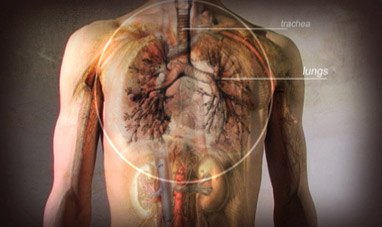The circulatory system is a network of blood vessels that carries blood and other substances to every cell in the human body. Like a network of roads extending from a city center into the suburbs, the blood vessel system is over 96,000 km long, almost two and a half times the earth’s circumference. In adults, the circulatory system can contain up to 6 liters of blood.
It reaches deep into the body, and all the way to its surface, from inner organs like the liver and intestine up to our skin. Some parts of the body, however, have no circulation: the corneas in our eyes, the hair on our heads and body, nails, and the enamel on our teeth. The engine driving blood circulation is the heart. Starting from the heart, blood takes two different routes. One is called systemic circulation, the other pulmonary circulation.
Systemic circulation begins in the left side of the heart and takes blood all over the body by means of extremely elastic blood vessels called arteries. It then returns to the right side of the heart through veins, a separate network of blood vessels that are less elastic than arteries.
Arteries carry arterial blood, which is rich in oxygen. Arteries get thinner in the peripheral parts of the body, becoming capillaries. The smallest capillaries have a diameter of only seven microns, roughly 10 times thinner than a single hair. Capillaries are this thin because they have to reach every cell in the body, bringing oxygen and nutrients.
The same blood then leaves the cells, loaded with carbon dioxide and waste substances, returning to the right side of the heart through the network of veins. Here it is pumped into the pulmonary circulation, which connects the heart with the lungs. In the lungs, blood is cleaned, receiving fresh oxygen. It then returns to the left side of the heart, ready to travel back towards the cells.
Circulation also has other functions: it carries platelets, which produce scar tissue to repair wounds, as well as antibodies and white blood cells, which protect the body from diseases. The first person to describe the circulatory system in detail was English doctor William Harvey, a graduate of the University of Padua in Italy who first published his research in 1628.
But the flow of blood was already outlined as early as the Fifth Century BC in the multivolume text Neijing, created in honor of the legendary Chinese emperor Huang Di. Beginning with a notion of correspondence between the human body and the universe, the Neijing identify the most important blood vessels and their pathways.
Today the Neijing are still used as a reference textbook for traditional Chinese medicine and acupuncture.
It reaches deep into the body, and all the way to its surface, from inner organs like the liver and intestine up to our skin. Some parts of the body, however, have no circulation: the corneas in our eyes, the hair on our heads and body, nails, and the enamel on our teeth. The engine driving blood circulation is the heart. Starting from the heart, blood takes two different routes. One is called systemic circulation, the other pulmonary circulation.
Systemic circulation begins in the left side of the heart and takes blood all over the body by means of extremely elastic blood vessels called arteries. It then returns to the right side of the heart through veins, a separate network of blood vessels that are less elastic than arteries.
Arteries carry arterial blood, which is rich in oxygen. Arteries get thinner in the peripheral parts of the body, becoming capillaries. The smallest capillaries have a diameter of only seven microns, roughly 10 times thinner than a single hair. Capillaries are this thin because they have to reach every cell in the body, bringing oxygen and nutrients.
The same blood then leaves the cells, loaded with carbon dioxide and waste substances, returning to the right side of the heart through the network of veins. Here it is pumped into the pulmonary circulation, which connects the heart with the lungs. In the lungs, blood is cleaned, receiving fresh oxygen. It then returns to the left side of the heart, ready to travel back towards the cells.
Circulation also has other functions: it carries platelets, which produce scar tissue to repair wounds, as well as antibodies and white blood cells, which protect the body from diseases. The first person to describe the circulatory system in detail was English doctor William Harvey, a graduate of the University of Padua in Italy who first published his research in 1628.
But the flow of blood was already outlined as early as the Fifth Century BC in the multivolume text Neijing, created in honor of the legendary Chinese emperor Huang Di. Beginning with a notion of correspondence between the human body and the universe, the Neijing identify the most important blood vessels and their pathways.
Today the Neijing are still used as a reference textbook for traditional Chinese medicine and acupuncture.






































